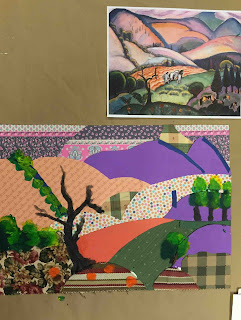 |
| Box o' Joe Image Source: dunkindonuts.com |
Then I was out at Hobby Lobby the other night and happened to see foam candy shapes. The package had 100 foam shapes for $5.99 but it was on sale for $3. There were gingerbread people, red and green glittery gumdrops, and red and green starlight mints (all peel and stick). Unfortunately, I do not see these on their online site, but you could probably get similar items near you.
This was a great craft for us to do together but with little involvement from me. I love crafts like that where I don't have to set the pace and she can really go on her own and make the project her own. I was there just there to make the windows and use the glue gun, if needed. It was a relaxing, calorie-free project that will last throughout the holiday season!
Enjoy!
--------------------
And in case you are looking for step-by-step directions, here they are!
Materials Needed:
- 1 empty Box 'o Joe from Dunkin Donuts (remove the bag of liquid and discard)
- A piece of red corrugated cardboard for the roof and windows (our piece was 12" square and came from our recycling bin)
- Scraps of yellow or orange paper, optional, for the windows
- Scraps of green paper for trees
- Hot glue and glue gun
- Scissors and an X-acto knife
- Tempera paint (brown, white, red (for roof, if you can't find red cardboard))
- Paint brushes
- Glitter glue (totally necessary!!)
- Bag of sticky-backed foam candy shapes (or you can make your own decorations)
- A base for your creation--ours is a cardboard used when cake decorating
Directions:
- Paint the outside of the box with brown tempera paint. Let dry.
- Cut a square for the roof and edge with white paint. Let dry.
- Cut a slit in the roof and slide it over the handle of the box. Adhere with hot glue.
- Adhere the entire box to the base now, if you'd like.
- Create some windows by cutting 6 little strips of red cardboard and glueing them to make a window. Glue the window frame to a piece of yellow or orange paper, if desired to create the illusion that a light is on inside the house. Make as many windows as you like and glue to the house with hot glue.
- Now's the fun part--stick candy all over the house! I love peel-and-stick foam shapes so that the kids can to it themselves and don't have to wait for glue to dry.
- Create trees from paper and stand-up gingerbread people and attach them to the base with hot glue.
- Glitta it up baby!! I squeeze glitter glue on a paper plate and have my daughter use her finger or a paint brush to add some bling all over everything!
You are done! Enjoy your easy-peasy gingerbread house!
 |
| Box o' Joe Image Source: dunkindonuts.com |



















































